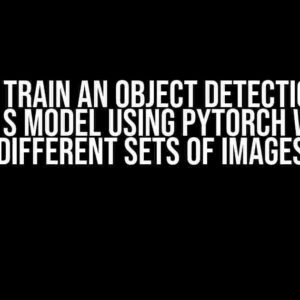Ah, the classic cry for help! Don’t worry, friend, you’re in the right place. We’re about to dive into the world of Machine Learning (ML) and tackle that pesky question that’s got you stumped. By the end of this article, you’ll be well on your way to becoming an ML whiz!
What’s the Question Again?
Before we begin, let’s take a step back and revisit the original question. You know, the one that’s got everyone’s attention:
Hey, can anyone help me with this basic ML question?
Yep, that’s it! Simple, yet powerful. It’s like the ML equivalent of “Hello, World!”
Getting Started with ML
Before we dive into the meat of the question, let’s cover some basics. If you’re new to ML, don’t worry – we’ve got you covered! Here’s a quick rundown of what you need to know:
- Machine Learning (ML): A subset of Artificial Intelligence (AI) that involves training algorithms to make predictions or decisions based on data.
- Supervised Learning: A type of ML where the algorithm is trained on labeled data to make predictions on new, unseen data.
- Unsupervised Learning: A type of ML where the algorithm is trained on unlabeled data to discover patterns or relationships.
- Neural Networks: A type of ML model inspired by the human brain, composed of interconnected nodes (neurons) that process inputs.
Feel like you need a refresher? No worries! Take a few minutes to review these concepts, and we’ll wait patiently for you to catch up.
The Question: Broken Down
Now that we’ve got the basics covered, let’s dissect the original question. We’ll break it down into smaller, manageable chunks to make it easier to understand and tackle:
Hey, can anyone help me with this basic ML question?
The question can be broken down into three main parts:
- The Ask: “Hey, can anyone help me…” – This is the intro, where you’re asking for assistance.
- The Question: “…with this basic ML question” – This is the meat of the question, where you’re asking for help with a specific ML problem.
- The Expectation: (Implicit) “Please provide an answer or guidance” – This is what you’re expecting from the person or people you’re asking for help.
Now that we’ve broken down the question, let’s tackle each part individually.
The Ask: Getting Attention
The first part of the question is all about getting attention. You’re reaching out to someone or a community, hoping they’ll notice your plea for help:
Hey, can anyone help me...
In this part, you’re:
- Being humble and acknowledging you need help
- Showing willingness to learn and understand
- Opening the door for someone to offer guidance
It’s essential to be clear, concise, and respectful in your ask. This sets the tone for the rest of the question and can make a big difference in the responses you receive.
The Question: Clarifying the Problem
The second part is where the magic happens. You’re sharing the specific ML question that’s got you stumped:
...with this basic ML question
In this part, you should:
- Clearly state the problem or question you’re facing
- Provide enough context for the reader to understand the issue
- Avoid jargon or technical terms that might confuse others
Be specific, be clear, and be concise. The more information you provide, the better equipped others will be to help you.
The Expectation: Getting Guidance
The third part is implicit, but crucial. You’re expecting someone to provide an answer, guidance, or direction to help you overcome your ML hurdle:
(Please provide an answer or guidance)
In this part, you’re:
- Expecting a response that addresses your question
- Hoping for guidance that’ll help you move forward
- Showcasing your willingness to learn and improve
Remember, you’re not just asking for an answer; you’re asking for help. Be open to feedback, suggestions, and alternative approaches.
Putting it All Together
Now that we’ve broken down the question, it’s time to put it all together. Here’s an example of what a revised question might look like:
Hey, can anyone help me understand the difference between supervised and unsupervised learning in Machine Learning? I'm new to ML and struggling to grasp the concept.
Notice how we:
- Started with a clear ask, showing humility and willingness to learn
- Clearly stated the question, providing enough context for the reader to understand the issue
- Implicitly expected guidance or an answer that addresses the question
This revised question is more likely to get attention, spark discussion, and receive helpful responses.
Conclusion
There you have it! With this guide, you should be well on your way to crafting a clear, effective, and engaging question that’ll get you the help you need. Remember:
- Be humble and open to learning
- Clarify your question and provide context
- Be respectful and grateful for the help you receive
So, the next time you find yourself screaming into the void, “Hey, can anyone help me with this basic ML question?”, take a deep breath, revisit this article, and ask your question with confidence!
| ML Concept | Description |
|---|---|
| Supervised Learning | Labeled data is used to train the algorithm |
| Unsupervised Learning | Unlabeled data is used to discover patterns |
| Neural Networks | Interconnected nodes (neurons) process inputs |
Happy learning, and I hope this article helped you tackle that basic ML question!
Frequently Asked Question
Don’t worry, we’ve all been there – stuck on a basic machine learning concept and feeling like a total noob. We’ve got you covered! Here are some answers to common ML queries:
What is the difference between supervised and unsupervised learning?
Supervised learning is when your model is trained on labeled data, and it learns to map inputs to outputs based on those labels. Unsupervised learning, on the other hand, is when your model is trained on unlabeled data, and it tries to find patterns or relationships within that data. Think of it like learning from a teacher (supervised) versus exploring and discovering on your own (unsupervised)!
How do I choose the right hyperparameters for my model?
The age-old question of hyperparameter tuning! There’s no one-size-fits-all answer, but here’s a pro tip: start with a baseline model, then use techniques like grid search, random search, or Bayesian optimization to experiment with different hyperparameters. Don’t be afraid to try different combinations and see what works best for your dataset!
What’s the difference between overfitting and underfitting?
Overfitting is when your model is too complex and memorizes the training data, performing well on that data but poorly on new, unseen data. Underfitting is when your model is too simple and doesn’t capture the underlying patterns in the data, performing poorly on both training and new data. Think of it like a model that’s too rigid versus one that’s too flexible – you want to find that sweet spot in between!
How do I deal with imbalanced datasets?
The perils of imbalanced datasets! One approach is to oversample the minority class, undersample the majority class, or use class weights to penalize the model more heavily for misclassifying the minority class. You can also try using different performance metrics, like F1 score or AUC-ROC, that are more robust to class imbalance. Just remember, there’s no one “right” way to deal with imbalanced datasets – experiment and find what works best for your problem!
What’s the concept of bias-variance tradeoff?
The bias-variance tradeoff is the eternal struggle of machine learning! Bias refers to the error introduced by simplifying assumptions in your model, while variance refers to the error introduced by the noise in your data. As you increase model complexity to reduce bias, you risk increasing variance, and vice versa. It’s all about finding that sweet spot where your model is complex enough to capture the underlying patterns, but not so complex that it’s prone to overfitting!


